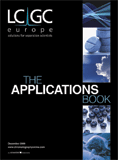Tracking Flavours in White Wine and Coffee Flavour Profiling of Food Samples with SPME-GC–MS and On-column Injection
The Application Notebook
SPME-GC–MS with on-column injection can be successfully employed for flavour profiling of food samples. The on-column injector of the GC-2010 can be used for SPME without any modifications, only an external ring adapter was used to facilitate the injection. The data can be compared with sensorial data of food.
SPME-GC–MS with on-column injection can be successfully employed for flavour profiling of food samples. The on-column injector of the GC-2010 can be used for SPME without any modifications, only an external ring adapter was used to facilitate the injection. The data can be compared with sensorial data of food.
Solid-phase microextraction (SPME) is a technique widely used nowadays for sampling in gas chromatography and GC–MS. The main advantage of SPME is that sample preparation is unnecessary (i.e., the compounds of interest are transferred directly from the matrix onto the SPME fibre). Particularly for the determination of volatile compounds this is a fast and easy-to-use method. In the application described in the following text, SPME was used in combination with GC–MS. The mass spectrometric detection enables secure identification of compounds by comparing them with mass spectra stored in commercially available mass spectral libraries (e.g., NIST, Wiley or customized mass spectral libraries).

Figure 1(a)
SPME with On-column Injection
In SPME, fibre desorption yields only some microlitres of vapour. If this desorption is done in a traditional split/splitless injector, the sample is diluted by the carrier gas. In the case of volatile compounds, this dilution necessitates application of cryogenic focusing. However, cryogenic focusing increases the complexity of the system and adds the need to use a cryogen such as CO2 or liquid nitrogen. Another disadvantage of using the split/splitless injector with SPME is the fact that permanent gases, such as argon for example, can not be analysed. Direct desorption into a 0.53 pre-column (10–15 cm long) directly coupled to the analytical column allows bypassing of this step. In this case the full range of boiling points can be analysed.

Figure 1(b)
As a result of the low activity of the injection step degradation of labile compounds can be minimized. It is, therefore, also possible to analyse sulphur compounds that are usually difficult to analyse because of degradation processes in the injector. The OCI-PTV injector of GC-2010 is able to perform on-column SPME injection without any modification and only an external ring adapter is needed.

Table 1
Flavour Profiling of Food Samples
In this application a white wine sample and a coffee sample were analysed using SPME-GC–MS with on-column injection.
Figure 1(a) shows the complete chromatogram of a white wine sample; Figure 1(b) shows the mass traces of several volatile compounds in the sample. The peaks eluting before 100 °C are not sufficiently trapped because of the flash desorption and are, therefore, asymmetrical but they are narrow and can be used for quantification. As a reference the argon peak is shown as well. In this application, argon was used as "pseudo internal standard". In some instances it is difficult to find a suitable internal standard — and if the samples are solid it is impossible. As argon is stable and inert and its concentration in air is constant, argon is used for normalization of the peak areas. Often, the real concentration is not of interest. The data is compared with sensorial data of food to find statistical correlations between the measured aroma profile and human perception. With argon as internal standard the peak areas can be normalized over weeks and also after recalibration of the MS detector.

Figure 2(a)
Figure 2(a) shows the latest eluting compound of the coffee sample, linoleic acid ethyl ester. In Figure 2(b) a range of sulphur compounds is shown, which were detected in the same coffee sample. As mentioned before, these sulphur compounds are very labile and not easy to analyse using GC–MS, but with SPME on-column injection they can be transferred to the column without degradation.

Figure 2(b)
Summary
SPME-GC–MS with on-column injection can be successfully employed for flavour profiling of food samples. The on-column injector of the GC-2010 can be used for SPME without any modifications; in this case only an external ring adapter was used to facilitate the injection. In this application argon, which is inert and stable, was used as "pseudo internal standard" for peak area normalization. The data can then be compared with sensorial data of food to find statistical correlations between the measured aroma profile and human perception.

Shimadzu Europa GmbH
Albert-Hahn-Str. 6-10, 47269 Duisburg, Germany
tel. +49 203 7687 0 fax +49 203 766625
E-mail: shimadzu@shimadzu.eu
Website: www.shimadzu.eu

New Study Reviews Chromatography Methods for Flavonoid Analysis
April 21st 2025Flavonoids are widely used metabolites that carry out various functions in different industries, such as food and cosmetics. Detecting, separating, and quantifying them in fruit species can be a complicated process.
Analytical Challenges in Measuring Migration from Food Contact Materials
November 2nd 2015Food contact materials contain low molecular weight additives and processing aids which can migrate into foods leading to trace levels of contamination. Food safety is ensured through regulations, comprising compositional controls and migration limits, which present a significant analytical challenge to the food industry to ensure compliance and demonstrate due diligence. Of the various analytical approaches, LC-MS/MS has proved to be an essential tool in monitoring migration of target compounds into foods, and more sophisticated approaches such as LC-high resolution MS (Orbitrap) are being increasingly used for untargeted analysis to monitor non-intentionally added substances. This podcast will provide an overview to this area, illustrated with various applications showing current approaches being employed.

.png&w=3840&q=75)

.png&w=3840&q=75)



.png&w=3840&q=75)



.png&w=3840&q=75)















